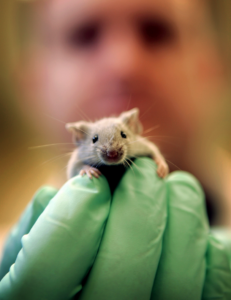
Here’s something you probably don’t know: over 90% of drugs that prove safe and effective in animal trials fail when they’re tried on humans. In 30% of those cases, the failure is because of harmful side effects, but the other 60% flop simply because humans are different from mice, dogs, and other species widely used in medical research.
So it’s fair to ask: why are more than 115 million animals still sacrificed every year for medical testing around the world?
The U.S. government is starting to wake up to the contradictions of animal testing: in September, the FDA Modernization Act 2.0, co-sponsored by Senators Rand Paul (R‑KY) and Cory Booker (D‑NJ), passed the Senate with bipartisan support. If approved by the House and signed into law by President Biden, it would remove the mandate that all drugs be tested on animals before proceeding to human trials. However, the bill does not ban or limit animal testing, and it is unclear how many scientists would shift to alternative methods, such as tests on human tissue or organ models created to mimic the human body system. So while this is welcome news, it would only be a first step. Animal testing needs to be severely restricted on the federal level, and scientists need incentives to use other options.
Animal testing is not completely worthless. In 1921, for example, the effectiveness of the crucial antibiotic penicillin was discovered by testing mice. But focusing only on the instances when animal and human results have aligned is dangerous, because it ignores the overwhelming number of cases where animal testing has misled scientists.
Since monkeys have similar DNA to humans, people generally assume that monkey testing is helpful, but there is plenty of evidence it’s not. For example, more than 100 HIV/AIDS vaccines proved safe and effective in testing on primates, and yet, in the following 700 human trials, none worked. Not only did this cause unnecessary animal suffering, but it also directly harmed humans: when the “promising” Merck’s V520 vaccine entered human trials, thousands of participants actually became more likely to become infected with HIV/AIDS after injection.
Vioxx, an anti-inflammatory drug, passed at least eight studies on African green monkeys and received FDA approval. Eighty million prescriptions were written under the false assumption of its safety, and the drug went on to kill 140,000 people worldwide, including 60,000 Americans, due to heart attacks and other deadly cardiovascular events.
The bodies of different species do not function the same way, and reactions to both diseases and drugs vary unpredictably. Anti-inflammatory drug testing on mice continues to fail for this reason. In a 2013 study, researchers compared the genetic responses of mice and humans when faced with severe inflammatory stress. Across the board, human genes and their corresponding mouse genes only responded in the same way 50% of the time— a statistic that could easily be explained by random chance. Another study of six drugs compared animal and human test results and found that three did not align in safety or effectiveness while the other three did, once again suggesting a random result. If animal testing is only as reliable as flipping a coin, how beneficial can it be?
There are better options. In vitro testing, for example, uses materials from the human body, such as cells and tissues, in culture flasks or petri dishes. This kind of testing revealed the efficacy of the drug zidovudine in HIV treatment, and also elicited valuable information about the virus’s structure and binding processes. Scientists have also invented ways to more holistically mimic organs and the larger human body system. Tissue chips can serve as models for both the structure and function of individual organs; these chips can then be connected to one another to predict a drug’s effects as it travels through the body. This technology has been useful in measuring efficacy and toxicology of drugs.
We need accurate evidence of both the safety and effectiveness of drugs before we test them in humans, but animal testing isn’t the answer. It’s time for scientists to commit both their time and resources to techniques that better mimic the human body and provide more accurate results.








